It’s been two months since I implemented our work plan routine. Though it improved things, I still disliked how we went about it. In my ideal scenario, a child creates their work plan on Monday, then look through it daily to create a todo list. All this done without much much of my input except maybe for me to look it over and “approve”. Of course, this is why I got into trouble. I typically have big lofty ideas in my head of a super autonomous child, and then get frustrated when they don’t get there due to my limited guidance. Then I get into this infinite loop of nagging to get them to get there, them resisting, and me nagging some more.
It occurred to me recently that the Work Plan is part of the 3 stages of work; where you take out the material, work on it, and then put it away. This is one of those reasons why I like the philosophy, that it isn’t about just being able to master a concept like doing laundry for children or being able to add. Instead it says it’s equally important to plan and know what it is you want to do, execute it, and clean up. All important soft skills.
Work plan Fall 2014
Our work plan by the end of December composed of three parts.
- Weekly Work Plan
The weekly work plan has 4 major areas, each with individual threads. For example, Language has reading, writing, handwriting, etc. Areas that need to be done daily are highlighted in yellow. Some parts are filled in by me Sunday night and others are done by Thumper during our planning session. For example, she writes down herself the 3 letters she will work on in handwriting weekly. The weekly work plan is filled out once a week at the beginning of the week. - Weekly Work Record
The work record has little rectangles where Thumper records down what she has done. She sometimes draws, sometimes writes in zhuyin, sometimes English, sometimes Chinese. There is an indirect component here in that she will learn how to write some Chinese characters since they’re typed in the Work plan by me. - Index Card system
The index cards are where the individual work unit, the todo list so to speak, is written down. She is supposed to look at the Weekly work plan daily to decide on what she wants to do, pull out the equivalent cards and sort them in the order she wants to do them.
From my discussion with my trainer, my understanding is that while there is an overall guideline in what a child needs to accomplish, imposed by the threads listed in the work plan and in my case, highlighted threads to be done daily, the freedom of choice comes in two forms:
- how much work they want to do per thread, decided after discussion with me.
- for each work goal, how much work they want to do every work period to reach that goal, this can be from no work to some to all work.
So for example, we write down she does 8 problems in subtraction this week, and she is to decide on how many problems she will work on each work period.
One problem with this work plan was that very very often she will put off the items she said she will do and she won’t do them. For example, the fraction equivalency work. It got left on the work plan week after week because she always left it. Some days we were out all day on Friday and this would not get done. Other days, she runs out of time by the end of the Friday work period. There were no consequences unlike a school. Home life just gets in the way and I can’t be consistent.
Work plan Spring 2015
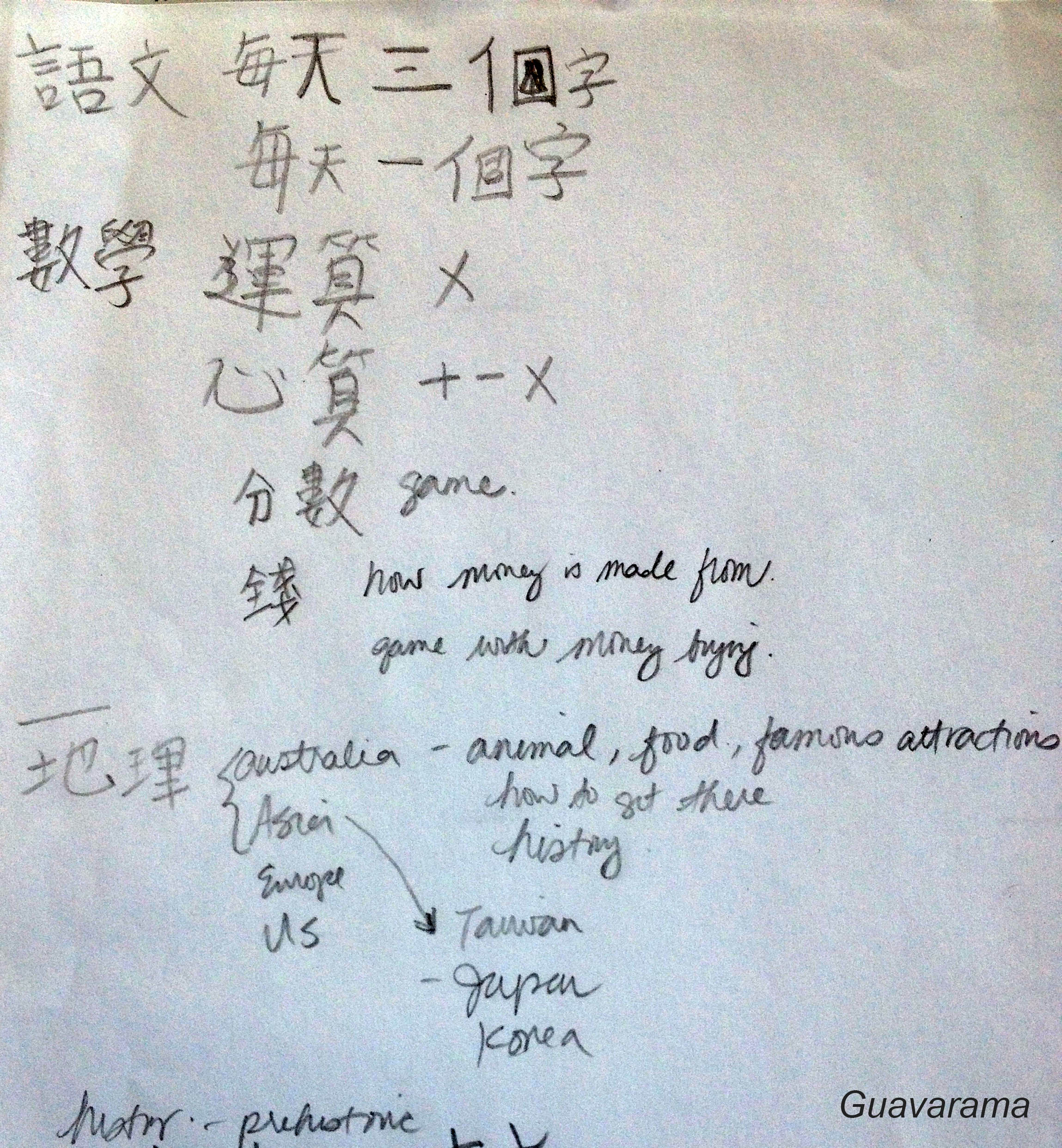
Wanting this semester to be different, I dragged Thumper into a meeting on our first day of Spring semester. She hates these meetings because she just wants to dive into work. I asked her what she wanted to study this semester and her goals in the different subjects and I wrote it all down into a Master Contract. I told her this is our contract for what she wants to learn this semester. It’s a way for her and me to remember what she wants to learn so that I can help her find material. Even asked her to sign her name and everything. This is how I learned that she wanted to know more about where money came from and how money is different between the U.S. and Taiwan.
That same week, I read Montessori Homeschooling‘s post about how you need to discuss the work plan with your child. And I had to whack myself on the forehead. As usual, I know of the concept, but I’d forgotten how important this is in the planning of a child’s work. I chalk this up to my anxiety that we can’t cover everything we need to cover if I let Thumper choose. Because every week I would see the work she hadn’t finish and in order to make her finish, I would put it on the work plan again. It isn’t that we didn’t discuss the work plan together, but she wasn’t really asked what she wanted to learn and what she liked or didn’t like about some work. That was the piece I was missing.
The Monday after, for our weekly meeting, I made some changes to our work plan meeting. Of course, the devil’s in the details. She’s not at a point where she will willingly go and plan her day or her week. Maybe because it’s still a lot of what Mama Lao-shi dictates. Though I’m slowly trying to change that. But I think another reason is because I haven’t broken down the steps on how to plan for her. So this is the habit part I’m trying to establish with her right now.
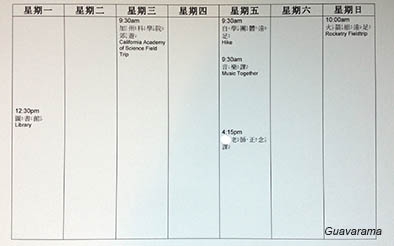
Each Monday, we start with our Weekly Calendar. This is a new “calendar” I put out so she has an idea of the major outings, commitments we have this week. For example, the fact that we have to go swimming daily, or that we have library time on monday or a playdate on Friday. She is to write that down. She also writes down when I will make certain presentations. This part is actually for me so that I do not put off doing new presentations.
We then work on our Weekly Plan.
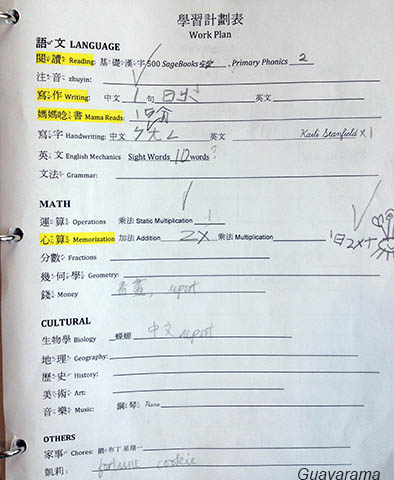
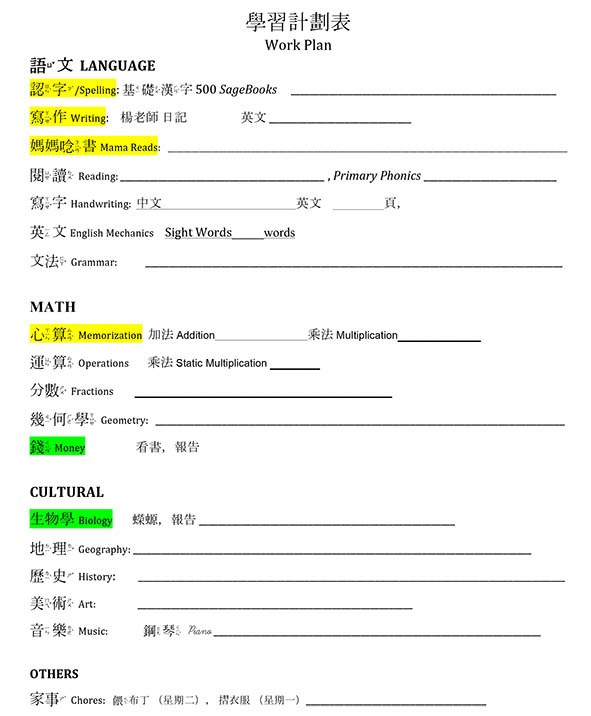
- First we look through all that she did last week. As we go through each thread, we check against her Work Record to see if she’d reached her goal. We discuss if the goal was too much or if she did not like the work. However, we add all the work she did not finish last week into this week’s additional work. I’m quite adamant about this as I want her to be able to plan ahead on what she wants to do, rather using procrastination as a way to not finish. For example, she had agreed in our Master Contract that she would learn 12 Chinese characters a week. If she doesn’t finish, we add those words to the words she has to learn this week.
- We then go through this weeks’ Weekly Plan and fill in the blanks. Usually I’ve already worked on this plan on Sunday to fill in parts I really want her to continue on. For example, the Sagebook work or Sight words. Otherwise I’m hoping as this semester progresses, she works more on more on planning her week herself. We re-discuss as we go through how much work she wants to do per week, if her idea of how many units of work is too much or too little, etc.I filled in spots that are more complicated to write, since she’s not writing much yet. I’m so thankful that I read the post. Ultimately I like it much more when she plans her own work and having an in depth conversation about it help us toward that goal, as compared with me telling her what needs to be done and having her write it down. I think it also helped that she’s done this for 3 months already and has an idea of her work progression.Having the Weekly Calendar also changes how much work we will put on our Weekly Plan. This planning part really is nebulous and requires some more advanced planning skills. Because there are no rules. You kind of have to have a feel of how much work you’re able to accomplish each week. I’m really hoping after practicing awhile, she gets this.
I’ve made two more changes to our weekly plan. And much like What Did We Do All Day, I’m allowing items to span two weeks as I find that the longer items like research and writing don’t ever get done otherwise. This is now highlighted in green. I just kind of have to figure out how to denote this is the second week. Another change I made this semester was to put EVERYTHING she needs/wants to do during the day into work plan or daily plan. This includes feeding Pudding, folding laundry, new project ideas she comes up with during the day, even Reflex Math. Otherwise she never does them.
Everyday, we work on our Daily Plan the minute we come into the classroom.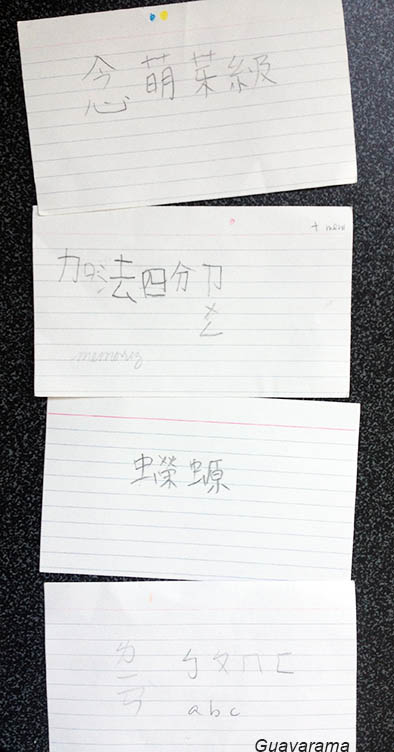
- Look through her list of cards from yesterday and pull out the index cards she did not finish. These are her first items to do today. She is not allowed to move these items to the back.
- Look through her Weekly Work plan and pull out ONE CARD that is her project of the day. This is so that she definitely works on long projects or things that interest her first, ala, Getting Things Done.
- Look through her Weekly Work Plan and pull out index card of work she wants to do. She of course has to pull out cards in the highlighted yellow thread. This is usually where I try to gently remind her that an item needs to be done since she doesn’t have a long term view of the week yet.
- She then looks through and sorts the index cards in the order she wants to do them.
- She looks through our Weekly Calendar to see what plans we have today. I check her ordered cards with her and we may take off a few items at the back of the todo list due to our plans.
- After she finishes one work, she is to write them down onto her Work Record Log.
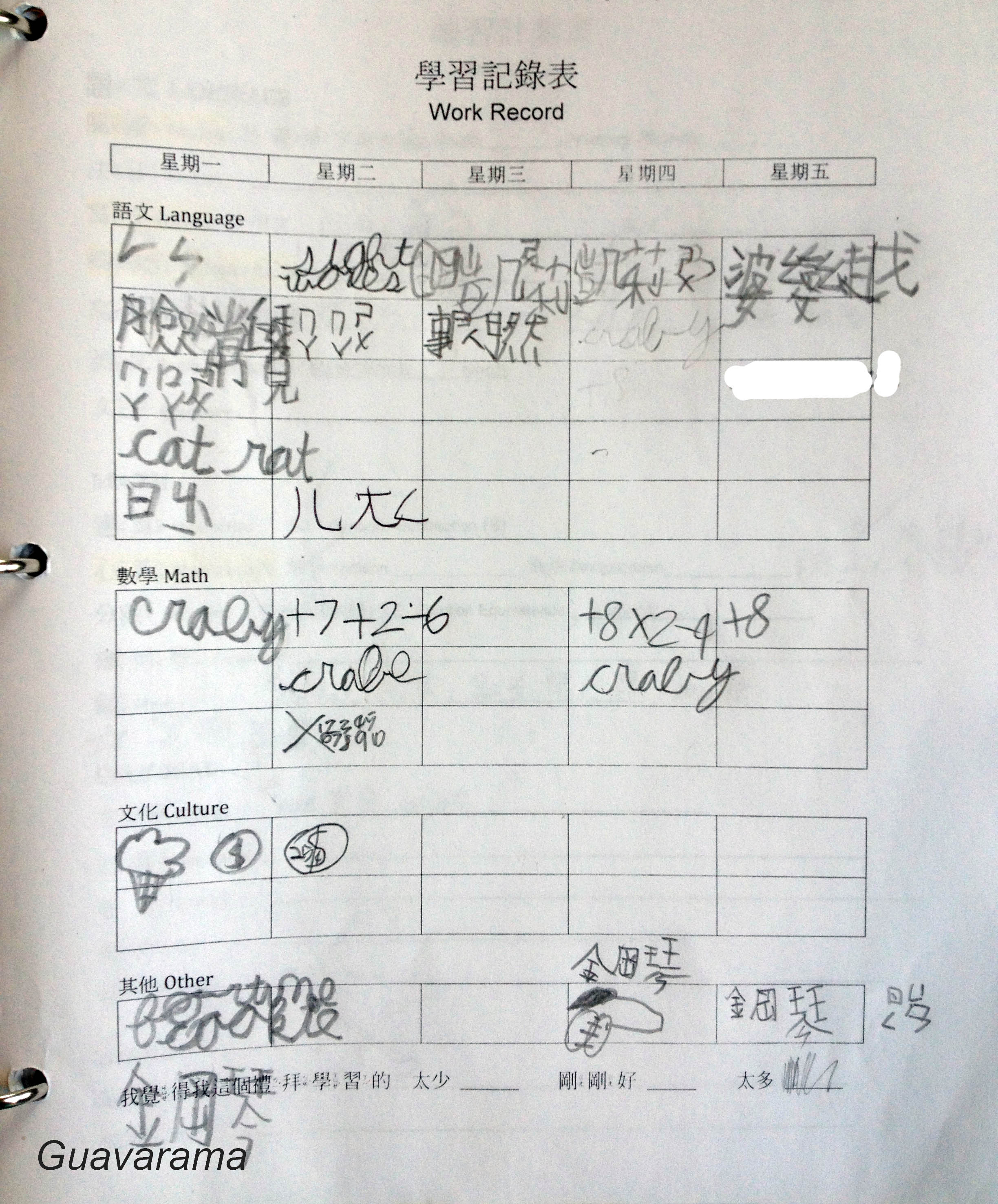
The last week or two, I’ve actually been “making” her to finish her unfinished work by the end of the day. More about this when I discuss Time Management in another post. I don’t want to make her do things. But I’m still contemplating what it means to work in general.
The hard part for me right now is knowing how much work a child typically can do in a three hour work period. For example, I can tell you for 3-6, 1-3 work is probably all some children can do. The rest they’re socializing, moving around, eating snack, doing their chosen work again and again, etc. I don’t know what it is for the 6-9 child. If I know this part, then I would be able to help Thumper plan her week better. Maybe it is time to do some detailed observations.
The work planning part gets better and better each day. It’s really hard for impatient me to wait for a habit to form. I have to constantly remind myself to remember how much more independent she is now compared with last semester.
